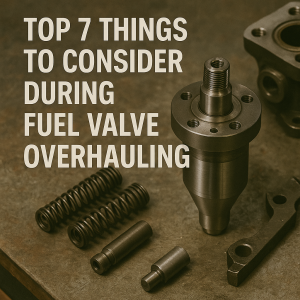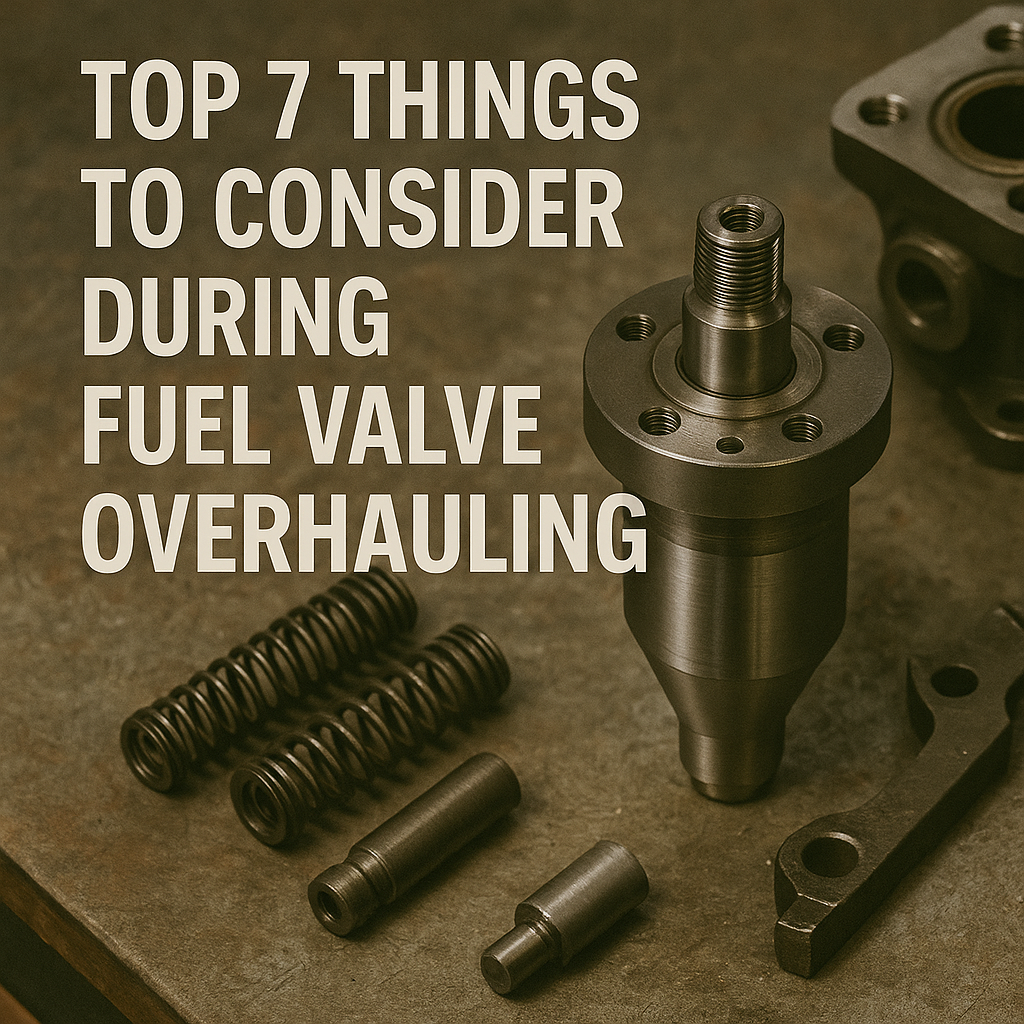Discover the top 7 things to consider during fuel valve overhauling for marine diesel engines. Learn expert insights, real-world tips, and safety protocols to improve engine efficiency and reliability.

Why Fuel Valve Overhauling Matters in Modern Maritime Operations
In the world of maritime engineering, the fuel valve may be a small component—but its role is anything but minor. A well-maintained fuel valve ensures optimal combustion, minimizes emissions, and prevents catastrophic engine damage. Onboard a vessel where the main propulsion depends on a large two-stroke or four-stroke marine diesel engine, fuel injection precision is paramount.
Overhauling a fuel valve isn’t just about mechanical diligence; it’s about understanding combustion dynamics, fuel pressure calibration, emission controls, and SOLAS-compliant safety procedures. When overlooked, worn or leaking fuel valves can result in poor engine performance, black smoke, unburnt fuel, or worse—engine room fires.
In a world moving toward digitalisation and cleaner fuels, knowing how to overhaul fuel valves correctly is a professional must for every marine engineer, engine cadet, or maintenance superintendent.
Understanding Fuel Valve Function and Design
The fuel valve (also called a fuel injector) is a precision device designed to atomize fuel and deliver it into the combustion chamber at high pressure, in a fine spray pattern. In marine diesel engines, these valves are designed for high durability—but not immortality. Carbon deposits, wear, erosion, and corrosion can degrade performance over time.
Fuel valve maintenance is often scheduled during routine overhauls—such as every 1,000 to 2,000 running hours—or based on engine manufacturer recommendations like MAN Energy Solutions, Wärtsilä, or Yanmar.
Let’s explore the top 7 things to keep in mind during fuel valve overhauling.
Cleanliness and Work Environment Control
Before starting any disassembly, maintaining a clean and controlled environment is critical. Even a microscopic particle of dirt can block injector nozzles or score the internal surfaces.
Key Considerations:
- Use lint-free cloths, clean trays, and sealed containers.
- Ensure good lighting and avoid wind or humidity exposure.
- Cover disassembled components immediately with protective wraps.
Real-World Tip: Some engine rooms now have designated clean zones for fuel valve overhauling to reduce contamination risk—especially when handling electronic injectors.
Visual and Dimensional Inspection
Once disassembled, inspect all parts for wear, scoring, erosion, and cracks. Use a magnifying glass or borescope for detailed visual checks. Measure nozzle tip diameter, needle lift clearance, and seat condition.
Tools Recommended:
- Vernier calipers, micrometers
- Dial gauges
- Manufacturer-specific jigs and templates
Standards: Refer to ClassNK, DNV, or ABS classification society guidelines or OEM manuals for acceptable wear limits. If the needle lift exceeds OEM tolerances, the valve must be replaced or repaired.
Nozzle Cleaning and Carbon Removal
Carbon buildup is a major issue for fuel valves. It affects spray pattern and atomization, leading to incomplete combustion. Use ultrasonic cleaners or carbon scrapers depending on manufacturer guidelines.
Do NOT: Use hard metal tools that may damage nozzle tips or sealing surfaces.
Advancement: Wärtsilä and MAN have introduced new coatings on nozzle tips to reduce carbon adhesion—always verify compatibility before cleaning.
Leak-Off Testing and Spray Pattern Verification
Testing the overhauled fuel valve is essential before reassembly. Spray pattern must be uniform and cone-shaped without streaks. Leak-off tests detect internal leakage that may not be visible.
Test Bench Calibration: Use pressure pumps (manual or hydraulic), test benches with calibrated pressure gauges (as per ISO 12156 or OEM standards).
Good to Know: Fuel valves for newer common rail systems may require electronic control and sensor calibration before spray pattern testing.
Replacement of Seals, Gaskets, and Crush Washers
Old seals and washers can harden, flatten, or degrade with heat. Always replace these with OEM-certified spares during overhauling.
Common Parts to Replace:
- O-rings
- Sealing washers (copper/aluminum)
- Spring plates (if deformed)
Safety Note: Never reuse high-pressure sealing components. It compromises fuel tightness and invites leaks.
Torque Settings and Assembly Sequence
Reassembly requires strict adherence to torque values. Uneven torque can deform the valve body or cause nozzle tip misalignment.
Follow OEM Specs: Each manufacturer (e.g., Yanmar, MAN B&W, Wärtsilä) provides a detailed assembly sequence and torque chart.
Example: MAN B&W recommends torquing nozzle retaining nuts in a crisscross pattern to ensure even surface contact.
Hint: Always use calibrated torque wrenches—calibration records may be audited by class or PSC inspectors.
Pressure Testing and Safety Verification
Once reassembled, conduct a final pressure test at the injector’s design opening pressure (often 250–1,500 bar, depending on the engine).
Things to Check:
- Correct opening pressure without delay
- No leakage at nozzle tip or body
- Uniform atomization without dribbling
Regulatory Input: According to SOLAS Chapter II-1 and the IMO Fire Safety Systems (FSS) Code, fuel system tightness must be verified to avoid risk of high-pressure fuel spray ignition.
Safety Tip: Wear proper PPE (face shields, gloves), and always bleed pressure slowly to avoid hydraulic injury.
–
Case Study: Fuel Valve Overhaul Failure Leading to Engine Breakdown
Incident: In 2021, a bulk carrier reported main engine power loss near the Malacca Strait. Investigation revealed that two fuel injectors had been overhauled a week earlier—but one had a faulty sealing washer reused. This caused high-pressure fuel leakage and uncontrolled injection, damaging the piston crown.
Takeaway: A minor oversight during fuel valve overhauling resulted in $80,000 in engine damage and two days of costly downtime.
Lesson: Never cut corners on parts or procedures—fuel valve overhaul is a precision job, not a routine task.
The Role of Classification Societies and Best Practices
Fuel system integrity is closely monitored by classification societies like DNV, ABS, Lloyd’s Register, and ClassNK. During periodic class surveys, maintenance logs and test records for critical components like fuel valves may be inspected.
Recommendations:
- Keep an overhaul log (date, engine hour, test pressure, replaced parts)
- Use only approved test benches and calibrated tools
- Follow STCW training for fuel system safety (IMO Model Course 2.07)
Emerging Technologies in Fuel Valve Diagnostics
Digital Monitoring: Some vessels now use real-time cylinder pressure and injector control sensors to monitor combustion anomalies. These systems (offered by Wärtsilä, Alfa Laval, and others) help identify malfunctioning valves without disassembly.
Future Outlook: AI-powered engine monitoring (as seen in the Fleet Xpress platform by Inmarsat) may eventually replace manual injector checks—but until then, human skill remains vital.
Frequently Asked Questions (FAQ)
How often should fuel valves be overhauled?
Typically every 1,000–2,000 hours, or as advised by the engine manufacturer and based on fuel quality and operating conditions.
Can I reuse the copper sealing washers?
No. Always replace sealing washers to ensure proper sealing and prevent leaks.
What is the acceptable spray pattern during testing?
A symmetrical, cone-shaped spray with fine atomization and no streaks or dribbling is ideal.
Are ultrasonic cleaners safe for all fuel valves?
Yes, but verify compatibility with coated or composite nozzles before use.
What happens if I skip spray testing?
You risk installing a faulty injector, which can lead to misfiring, poor combustion, and engine damage.
Can improper torque during assembly cause valve failure?
Absolutely. It can lead to misalignment, internal leakage, and premature wear.
Are electronic fuel injectors overhauled the same way?
No. They require additional calibration tools and may need manufacturer support or service center assistance.
Conclusion
Fuel valve overhauling is not just a maintenance checklist—it’s an art rooted in precision, patience, and professionalism. With fuel quality standards tightening, emission norms getting stricter, and engine performance demands rising, there’s no room for error.
Every marine engineer or engine cadet must treat fuel injectors with the seriousness they deserve. By following OEM guidelines, using proper tools, and respecting safety protocols, seafarers can ensure smoother sailing, fewer breakdowns, and safer operations.
From pressure testing to spray pattern evaluation, these 7 considerations are the cornerstone of effective fuel valve maintenance in the maritime industry.
References
- MAN Energy Solutions. (2023). Fuel Valve Maintenance Guide. https://www.man-es.com
- Wärtsilä. (2023). Marine Diesel Engine Overhaul Manuals. https://www.wartsila.com
- IMO. (2022). STCW Convention and Model Course 2.07. https://www.imo.org
- SOLAS Chapter II-1. (2022). Construction—Structure, Subdivision, and Stability. https://www.imo.org
- Lloyd’s Register. (2023). Marine Fuel System Safety Guidelines. https://www.lr.org
- Alfa Laval. (2023). Fuel Injector Cleaning and Diagnostics. https://www.alfalaval.com
- Inmarsat. (2023). Fleet Xpress for Marine Engine Monitoring. https://www.inmarsat.com
- Marine Insight. (2023). Common Mistakes in Fuel Injector Maintenance. https://www.marineinsight.com

